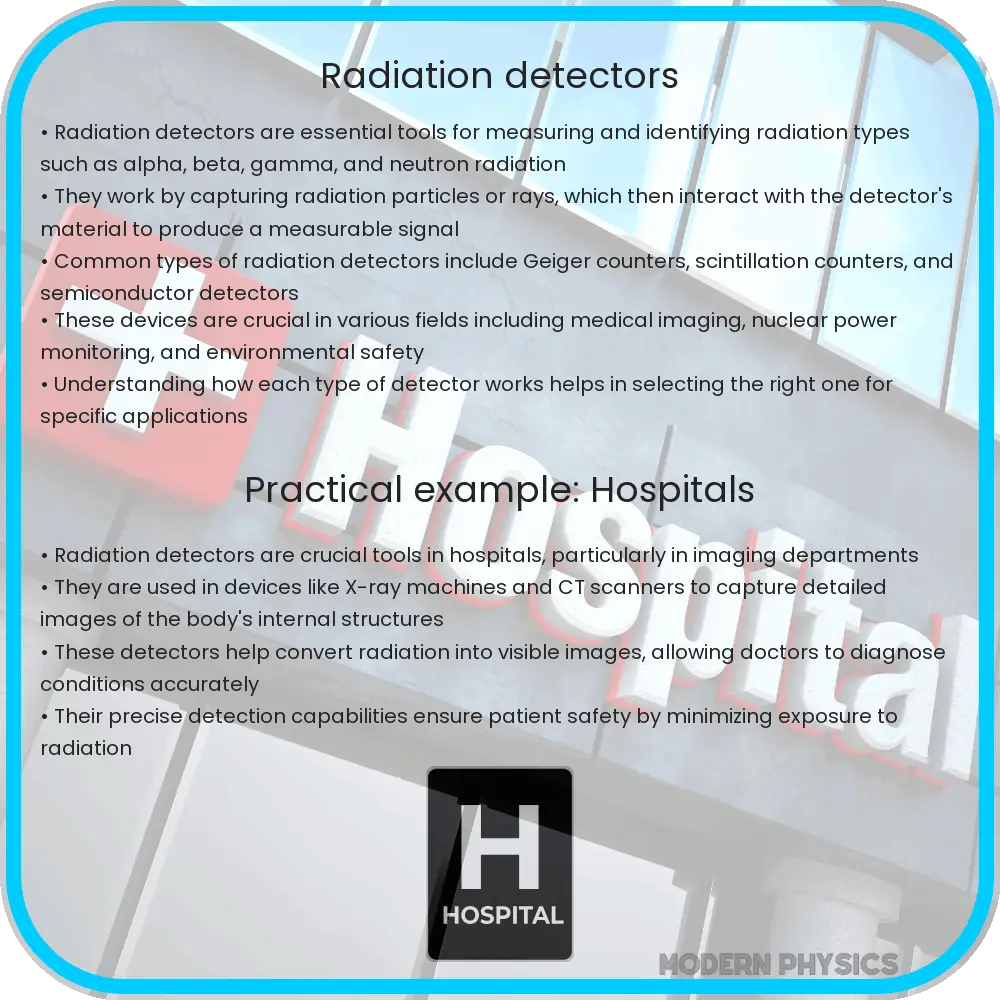Understand the essential roles, types, and safety protocols of radiation detectors in various applications, from medical diagnostics to environmental monitoring.

Introduction to Radiation Detectors
Radiation detectors are crucial tools used across various fields like medical imaging, industrial applications, and environmental monitoring. These devices allow us to detect and measure ionizing radiation, which includes alpha particles, beta particles, gamma rays, and neutrons. Understanding the functionality, accuracy, and safety features of radiation detectors can help in optimizing their use, especially in critical areas such as medical diagnostics.
Types of Radiation Detectors
There are several types of radiation detectors, each tailored for specific applications. Some of the most commonly used types include:
- Geiger-Mueller (GM) Tubes: Known for their ability to detect a wide range of radiation types. GM tubes are commonly used in health physics and for general radiation detection tasks.
- Scintillation Detectors: These use a scintillating material to convert radiation into light, which is then measured. They are particularly effective for detecting gamma rays and often used in medical imaging.
- Semiconductor Detectors: Often made from materials like silicon or germanium, these detectors provide high-resolution measurements of radiation energy levels, making them suitable for precise applications such as spectroscopy.
Accuracy of Radiation Detectors
The accuracy of radiation detectors is paramount, especially in contexts where precise radiation levels are critical for safety or outcomes, such as in radiation therapy. Several factors influence the accuracy:
- Detector Calibration: Regular calibration against known standards is essential to maintain accuracy over time.
- Energy Resolution: This refers to the detector’s ability to distinctly resolve different energies of incoming radiation. Higher resolution detectors are crucial in settings where distinguishing between different types of radiation is necessary.
- Response Time: The speed with which a detector can respond to radiation and provide accurate readings can significantly influence its effectiveness, especially in rapidly changing radiation environments.
Safety in Radiation Detection
Safety is a critical component when dealing with radiation detectors, not only to protect the equipment but also the operators and the environment:
- Shielding: Proper shielding with materials like lead or concrete is vital to protect users and sensitive equipment from unwanted radiation exposure.
- Area Monitoring: Installing radiation detectors in strategic locations around hazardous areas ensures continuous monitoring and rapid detection of abnormal radiation levels.
- Maintenance and Training: Regular maintenance of detectors and training for personnel on safe handling practices are crucial to prevent accidents and ensure reliable measurements.
Medical Applications of Radiation Detectors
In the medical field, radiation detectors play a pivotal role in both diagnostics and treatment. Applications include:
- Diagnostic Imaging: Technologies such as X-ray imaging, computed tomography (CT), and positron emission tomography (PET) rely heavily on radiation detectors to create detailed images of the body’s internal structures.
- Radiation Therapy: In cancer treatment, radiation detectors help ensure that the correct dose of radiation is delivered to the precise location, maximizing treatment effectiveness while minimizing exposure to healthy tissues.
- Radiopharmaceuticals: These are radioactive compounds used in nuclear medicine to diagnose and treat diseases. Detectors are used to precisely track the distribution and localization of these compounds within the patient’s body.
Environmental Monitoring Using Radiation Detectors
Radiation detectors also find significant applications in environmental monitoring. They help in assessing radiation levels in the environment to check for safety and compliance with regulatory standards. Applications include:
- Radioactive Contamination: Detectors assess areas for radioactive contamination, particularly after incidents at nuclear facilities or improper disposal of radioactive materials.
- Natural Background Radiation: These devices measure the naturally occurring radiation in the environment to establish baseline levels, important for identifying unusual spikes that might indicate contamination.
- Space Exploration: Radiation detectors are crucial in space missions, monitoring the levels of cosmic radiation that could pose risks to astronauts and equipment.
Future Trends in Radiation Detection Technologies
The development of radiation detection technology continues to evolve with advancements in material science and digital electronics. Future trends likely to shape the field include:
- Miniaturization: Smaller, more portable detectors are becoming increasingly prevalent, enhancing the convenience of deploying these devices in various settings.
- Enhanced Sensitivity: Ongoing research is focused on increasing the sensitivity of detectors, allowing for quicker and more accurate readings even at low radiation levels.
- Integration with AI and IoT: Integrating detectors with artificial intelligence (AI) and the Internet of Things (IoT) can provide smarter monitoring systems that predict and react to changes in radiation levels autonomously.
Conclusion
Radiation detectors are indispensable tools that serve a variety of crucial roles across medical, industrial, and environmental fields. Their ability to accurately measure different types of ionizing radiation ensures that they are integral in protecting human health, advancing scientific research, and maintaining safety in potentially hazardous environments. As technology progresses, the enhanced capabilities of these detectors, coupled with smarter, interconnected systems, are expected to further revolutionize how we utilize and understand radiation in various applications. The future of radiation detection is poised to bring even greater advancements, making these tools more effective, accessible, and integral to our handling of radiological challenges.
